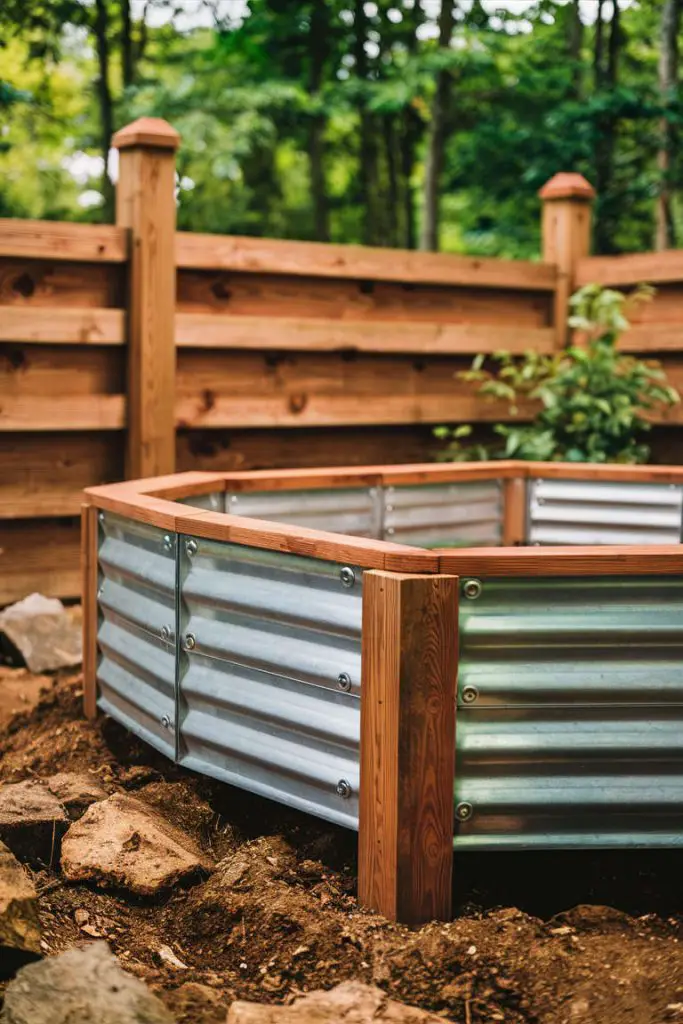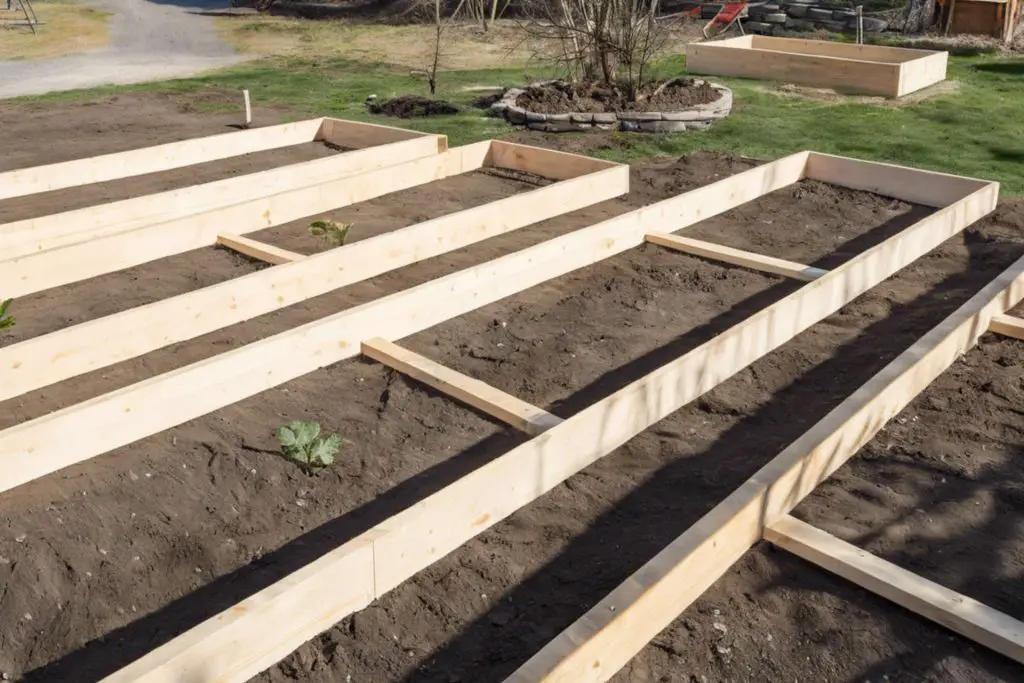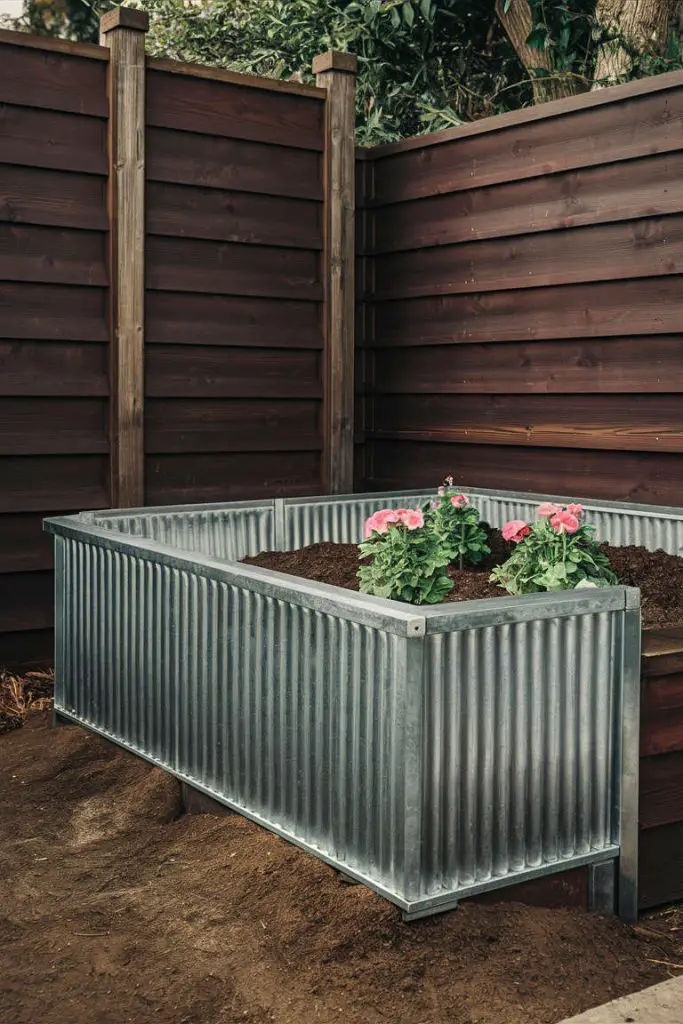Metal Raised Garden Beds DIY: Forge a Chic Garden Look
Metal raised garden beds offer a striking blend of function and aesthetics to your outdoor space. They offer a modern and efficient way to cultivate plants providing numerous benefits. Building your own allows for customization and cost savings, making it an attractive option for DIY enthusiasts and gardeners who enjoy building structures in their garden. By going the DIY route, you can tailor your garden beds to fit your specific needs and preferences, creating a space that’s truly your own.
Planning Your Metal Raised Garden Bed

Before you start to build your raised bed, you need to spend some time considering the dimensions and design of your raised bed as well as it position in you backyard.
Dimensions & Design
The design phase of constructing a metal raised garden bed is foundational to its success. This phase is not just about the physical construction but also involves strategic planning around the garden’s location and its interaction with natural elements, especially sunlight. Plants have varying requirements for sunlight, with some thriving in full sun and others in partial shade. Assessing the sun’s path across your yard will help you position the bed to meet these needs effectively.
Size and Ergonomics:
The size of the bed should cater to the specific growth requirements of your plants, such as root depth and spacing. A deeper bed, for example, is ideal for root vegetables, while shallower ones may suffice for herbs and some flowers. Additionally, the height of the bed should facilitate easy access for planting, weeding, and harvesting, reducing the need for bending and reaching. This consideration is vital for ergonomic comfort and can greatly enhance the gardening experience, making it more enjoyable and less of a chore.
Design Innovations

Moving beyond traditional rectangular beds to incorporate various shapes and structures can transform your garden into a striking landscape feature. Circular, hexagonal, or even undulating bed shapes can create a focal point in your garden. For urban gardeners or those with limited ground space, tiered raised beds offer a smart solution for vertical gardening, increasing the available planting area without expanding the garden’s footprint.
Incorporating functional yet creative corner designs can further enhance the utility and aesthetics of your raised beds. For example, integrating seating around the bed’s perimeter can provide a dual function of comfort for the gardener and structural support for the bed itself. Additionally, installing trellises at the corners allows for the cultivation of climbing plants, such as beans, peas, and some types of flowers, adding both beauty and yield to your garden space.
Personalization
The planning stage is an opportunity to inject personal style and preferences into your garden design. Whether you lean towards a minimalist aesthetic with clean lines and simple shapes or a more whimsical approach with curves and varied heights, your metal raised garden bed can reflect your personality. This personal touch not only makes the garden uniquely yours but can also become a source of pride and satisfaction as you watch your plants grow and thrive.
As you move forward with planning your metal raised garden bed, remember that this initial stage is critical. It sets the foundation for a garden that not only meets your practical needs but also fulfills your aesthetic vision. Take your time to consider all aspects of the design, from sunlight and size to shape and personalization, to ensure that your garden becomes a cherished part of your outdoor living space.
Type of Metal for DIY Metal Raised Garden Beds
Choosing the right material for your DIY metal raised garden bed is a step that demands careful consideration. Each material offers unique benefits and challenges, affecting the longevity, maintenance, and appearance of your garden beds.
Galvanized Steel
Galvanized Steel stands out for its robustness and resistance to corrosion, thanks to a protective zinc coating. This material suits gardeners looking for long-lasting structures that withstand various weather conditions without rusting. Its strength ensures the garden bed retains its shape over years of use, making it a practical choice for avid gardeners.
Corrugated Metal
Corrugated Metal not only provides structural integrity through its ribbed design but also adds an aesthetic appeal with its distinctive look. The texture of corrugated metal catches light and shadow, creating visually appealing effects in your garden space. Its durability and strength make it suitable for garden beds, offering a balance between functionality and style.
Aluminum
Aluminum is valued for its lightweight property, making it an excellent option for gardeners who might want to move their beds occasionally. Despite being lighter, aluminum is resistant to corrosion and can endure exposure to elements, though it may not offer the same level of sturdiness as steel options.
Weathering Steel
Weathering Steel, commonly known by the brand name Corten, develops a protective rust-like appearance over time that shields the metal underneath from further corrosion. This material is favored for its natural, earthy look that integrates well with outdoor garden environments. While it forms a protective layer, initial rusting can cause staining on surrounding surfaces, which is an important consideration when planning the placement of your garden beds.
The disadvantages of Corten steel are cost and limited aesthetics. Due to its unique properties and weathering capabilities it is generally more expensive than alternatives which can make the project cost more expensive than using materials such as galvanized steel or aluminium. Secondly, in terms of aesthetics, in its natural state, you a limited to the reddish brown hue of the patina that develops over time.
Types of Weathering Steel:
- Corten steel: The most common type, known for its characteristic rust color.
- S355JOW and S355J2W: European equivalents with similar properties.
- S355J0WP: Offers even better corrosion resistance.
Key Advantages of Using Weathering Steel for Building Raised beds:
- Unique aesthetic: The natural patina adds rustic charm.
- Low maintenance: Minimal upkeep once the protective layer forms.
- Considerations: Staining can occur during the initial rusting phase.
In choosing the material for your raised garden bed, weigh these factors alongside your gardening needs, aesthetic preferences, and the climate in your area.
Corten steel is an excellent choice for outdoor applications where a self-protecting, low-maintenance, and visually appealing material is desired. However, if budget constraints, higher strength, or different aesthetics are priorities, alternatives like stainless steel, galvanized steel, or aluminum might be more suitable. Always consider the specific requirements of your project before making a final decision
Whether you prioritize durability, ease of maintenance, or visual impact, the right material can enhance your gardening experience and contribute to a beautiful, productive garden.
Repurposing Househild Metal Items for Your Raised Beds
You don’t necessarily have to go to the effort of building a raised bed. It is possible to repurpose items that have reached the end of there life such as wheelbarrows or old fridges as these can make fantastic raised beds with a little work and imagination.
Tools & Materials List for Building Metal Raised Garden Beds

Constructing a metal raised garden bed requires specific tools and materials to ensure the project is both durable and visually appealing. Here’s a more detailed breakdown to guide you through the process:
Cutting Tools:
- Reciprocating Saw with Metal Cutting Blade: Ideal for cutting through thicker metal sheets, a reciprocating saw ensures quick, straight cuts. Ensure you have a blade specifically designed for metal to avoid damage and ensure efficiency.
- Metal Shears: For thinner metal sheets, manual metal shears offer precision. They allow for more control, making them perfect for detailed cuts or smaller projects.
Fasteners:
- Self-drilling Screws for Metal: These screws are designed to bore into metal without pre-drilling, saving time and effort. They come with a drill-shaped point to cut through the metal, allowing for quick and secure assembly of your garden bed panels.
- Wood Screws (If Using a Wooden Frame): Should your design include a wooden frame for additional structure or aesthetic purposes, wood screws will be necessary. They are designed to grip wood effectively, ensuring your frame is stable and secure.
Optional Materials for Added Stability and Weed Control:
- Wood for Framing: Adding a wooden frame to your metal raised bed can increase its stability and longevity. The wood acts as a natural complement to the metal, enhancing the bed’s appearance while providing a solid foundation.
- Landscape Fabric: Laying landscape fabric at the bottom of your garden bed can prevent weeds from growing up into the bed, saving you from future maintenance while still allowing water to drain.
- Weed Barrier: Similar to landscape fabric, a weed barrier adds an extra layer of protection against weeds, ensuring your plants don’t have to compete for nutrients and water.
Additional Considerations:
- Protective Gear: Don’t forget to equip yourself with gloves, safety glasses, and sturdy footwear to protect against sharp edges and metal filings during cutting and assembly.
- Drill Bits for Metal: For any pre-drilling needs or if using screws that require them, ensure you have metal-specific drill bits. These are designed to handle the hardness of metal without dulling.
Building Your Metal Raised Garden Bed: A Detailed Step-by-Step Guide
I. Safety Precautions
Initiating any construction project necessitates a focus on safety. Equip yourself with heavy-duty gloves to prevent cuts from metal edges, which can be sharp and unpredictable. Safety glasses are indispensable, safeguarding your eyes from metal filings or any debris generated during cutting. Additionally, wearing sturdy, closed-toe footwear is crucial to protect your feet from injuries that could occur if tools or materials are accidentally dropped.
II. Precision Cutting of Metal Panels
The foundation of a well-constructed raised garden bed lies in accurate measurements and precise cuts. Begin by marking your metal panels according to the desired dimensions of your garden bed, using a permanent marker for visibility.
For those using a reciprocating saw, which is ideal for thicker metal sheets, ensure the blade is specifically designed for metal to facilitate smooth cuts without damaging the tool. Metal shears are the tool of choice for thinner panels, offering control and precision for clean cuts. It’s a good practice to measure twice and cut once to avoid errors that could affect the integrity of your garden bed.
III. Assembling the Frame

If your design incorporates a wooden frame for structural stability, the frame should be constructed prior to attaching the metal panels. Use wood screws to assemble the frame, ensuring each joint is tight and secure.
Once the frame is ready, position the metal panels against it and secure them using self-drilling screws designed for metal. These screws eliminate the need for pre-drilling, streamlining the assembly process. The goal is to achieve a snug fit between the metal panels and the wooden frame, enhancing the durability and stability of the garden bed.
IV. Ensuring Adequate Drainage
Adequate drainage is essential for preventing waterlogged soil and promoting healthy plant growth. Strategically drill holes at the base of the garden bed, spacing them evenly to ensure uniform water distribution.
A layer of gravel at the bottom of the bed can further facilitate drainage, particularly beneficial in soil types prone to compaction. For gardeners in regions with high rainfall, considering a French drain system might be prudent. This involves creating a gravel-filled trench at the base of the bed, possibly with a perforated pipe, to efficiently channel excess water away from the plant roots.
V. Final Touches for Longevity and Aesthetics
For metal raised garden beds constructed from galvanized steel, applying a coat of metal-specific paint can offer additional protection against the elements while adding a touch of color to your garden.
Incorporating a top edging made from either wood or metal not only completes the look of your garden bed but also provides a practical ledge for seating or placing gardening tools during maintenance activities. This final step is about blending functionality with personal style, ensuring your metal raised garden bed is both a productive and pleasing addition to your outdoor space.
Paying attention to these five stages will allow you to build a metal raised garden bed that is robust, efficient, and aesthetically pleasing. Each step, from safety measures to precise cutting and thoughtful assembly, contributes to creating the bet possible structure.
Filling Your Metal Raised Garden Bed
After constructing your metal raised garden bed, it’s crucial to prepare it for planting. This process involves several detailed steps, ensuring your plants will thrive in their new environment.
Implementing a Weed Barrier
As previously mentioned in the Tools & Materials section, incorporating a weed barrier is a strategic move to mitigate weed growth. This step is crucial for maintaining a low-maintenance garden bed. After construction, lay down landscape fabric or a high-quality weed barrier cloth, cutting it to precisely fit the interior dimensions of your garden bed. It’s essential to overlap the edges slightly and secure them in place with garden staples. This barrier will act as a deterrent to weeds, attempting to grow from beneath while still allowing water and nutrients to penetrate the soil.
Choosing and Mixing the Right Soil
The vitality of your garden significantly depends on the soil composition within your raised bed. For optimal plant health, combine topsoil, compost, and potting soil in a ratio that supports the specific requirements of your chosen plants. Each component serves a purpose: topsoil provides a base, compost enriches the soil with organic matter and nutrients, and potting soil ensures good drainage and aeration. Mixing these components thoroughly creates a rich, loose, and fertile soil environment conducive to plant growth.
Planting Strategy

With the weed barrier in place and the bed filled with nutrient-rich soil, the next step is planting. Before this, however, it’s beneficial to sketch a layout of where each plant will go, considering their mature size and spacing needs. This planning prevents overcrowding and ensures each plant receives adequate sunlight, air circulation, and nutrients. Dig holes larger than the root balls of your plants, place them gently, and backfill with soil, pressing down lightly to eliminate air pockets. Water each plant deeply immediately after planting to help establish roots in their new setting.
You start to understand the importance of a good construction process when it comes to preparing your metal raised garden bed for planting. From laying a weed barrier to selecting the right soil mixture and carefully planning the planting layout all become more staightforward if the bed is well constructed. Filling out your bed thoughtfully will create a thriving environment for your plants.
Additional Tips & Resources
After setting up your metal raised garden bed and planting your chosen flora, consider these further tips and resources for optimal growth and maintenance.
Troubleshooting Common Problems:
- Rust Prevention: While metal raised beds are durable, some metals may rust over time. Regular inspections and applying a rust-inhibiting paint can extend their lifespan For weathering steel, allow the natural patina to develop.
- Soil Health: Keep the soil healthy by adding organic matter annually. Compost or aged manure enriches the soil, promoting vigorous plant growth.
- Pest Control: Monitor plants regularly for pests. Encourage beneficial insects or use environmentally friendly pest control methods to manage infestations.
Plant Spacing:
Proper spacing is crucial for plant health and yield. Overcrowded plants compete for light, water, and nutrients, leading to weaker growth. Follow recommended spacing guidelines for each plant species to ensure they have room to thrive.
Online Resources:
Several online platforms offer valuable gardening advice, from forums and social media groups to gardening blogs and websites. Extension services1 and local gardening clubs can also be excellent resources for region-specific information and support.
If you run into any problems utilizing available resources can ensure you get answers and enhance the success of your metal raised garden bed. Whether it’s preventing common problems, optimizing plant spacing, or seeking guidance from online platforms, these strategies contribute to a rewarding gardening experience.
